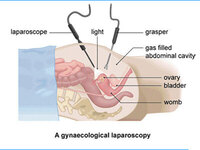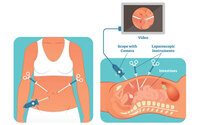Laparoscopic Myomectomy, also known as Robotic Myomectomy, is a super-advanced medical procedure that helps in removing fibroids through tiny abdominal incisions. Fibroids are tumors that develop around the uterus, and they are made from soft muscle cells and different fibrous connective tissue.
Laparoscopic Myomectomy surgery is done for various reasons; doctors recommend it when the fibroids obstruct your normal life activities if you want to bear children or if the uterine fibroids interfere with your fertility.
There are two other types of Myomectomy


Compared to open abdominal myomectomy & hysteroscopic myomectomy, laparoscopic myomectomy offers many benefits. These include:
A Laparoscopic myomectomy is a super advanced laparoscopic procedure & the success of this surgery depends very much on the skill, experience & expertise of the surgeon. Dr. Sarada Mamilla is the best gynaecologist & laparoscopic surgeon in Hyderabad, Telangana. She has over 20 years of experience in successfully performing laparoscopic myomectomies.
The patient would require a consultation during which the gynaecologist would ask her about her complete medical history, understand symptoms & recommend clinical examinations including an ultrasound.
An ultrasound is useful delineate the size, number & location of fibroids. In some cases, an MRI scan may be required especially if your doctor suspects Adenomyosis.


A laparoscopic Myomectomy procedure is performed with the help of a robotic instrument like a telescope to see the abdomen; clearly, it is inserted through the vaginal route to your uterus. Using the resectoscope, small cuts are made on the fibroids on the uterus, then small pieces of fibroids are removed through the vagina.
Generally 3 or 4 small incisions are made depending the uterine size. Typically one big incision of around 12 mm is made within the umbilicus & 2 to 3 smaller incisions or 5mm or smaller are made.
Some minimal complications can happen during the procedure, like injury to an internal organ, bleeding, or an infection. After the procedure, doctors recommend 24 to 48 hours of stay in the hospital. During this time, the patient will be prescribed oral medications for pain; gynaecologists also instruct dietary plans and activities. Vaginal spotting and staining are commonly expected.
Research and studies have given enough proof that is procedure is safe and gives good results; it has a very low rate of failure experience. In consideration of other surgeries to remove fibroids from the uterus, laparoscopic Myomectomy is the most appropriate, effective, and safest procedure.

Are you an international patient looking for the best gynecological care in India? Consult Dr. Sarada Mamilla, the best gynecologist & Laparoscopic Surgeon in India, offering top notch care for complex cases of uterine fibroids, endometriosis, adenomyosis & gynecological malignancies.
Copyright © 2023 All rights reserved By Dr.Sarada